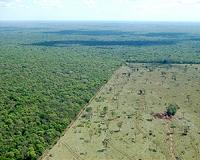| . |  |
. |
Haifa, Israel (AFP) Dec 7, 2010 Scorched and blackened areas of Israel's Mount Carmel forest, razed by the flames of the country's worst-ever fire, will take decades to return to their once-lush glory, experts say. The blaze, which began on December 2 and raged for four days, consumed at least 12,000 acres (4,800 hectares) of forest in an area sometimes dubbed "little Switzerland," destroying an estimated five million trees. The Jewish National Fund (JNF), a state-supported Zionist organisation which manages much of Israel's land, has encouraged Israelis to join efforts to replant the area during a tree festival in January. JNF chairman Efi Stenzler said the day-long Jewish holiday of Tu Bishvat -- the "New Year of the Trees" when people traditionally go planting -- would be extended for a full week and dedicated to "regreening" the Carmel. But experts say most of the hard work regenerating the forest will happen naturally, although it is likely to take decades. "The process of forest rehabilitation, the initial forest rehabilitation, is going to take five to 10 years," said Omri Bonneh, chief forester for the Haifa region of the Jewish National Fund. "But of course, most of the trees that were burnt were 50 to 100 years old, and we will have to wait decades to see the forest we love once again." Lea Wittenberg, a lecturer at Haifa University's geography and environmental studies department, agreed. "We think that it will be brought back to life, but in a different form of vegetation structure and diversity," she told AFP. "Nature is very strong and it regenerates very fast after fires, even after severe fires," she added. Dan Malkinson, an ecologist at Haifa University, said forest fires can actually enrich the soil by depositing nutrients, "and accordingly the revegetation process is accelerated following the fire." Both researchers cautioned against human intervention, warning that the forest would recover better if left to do so naturally. "We strongly advise leaving the place for the coming year, without entering the place, without doing anything," Wittenberg said. But the JNF's Bonneh said human intervention could promote biodiversity and protect new growth. "Natural regeneration itself does not mean that there is no need for intervention," he told AFP. The extent of the damage will take several weeks to assess, and it was unclear how the use of chemical fire retardants and large quantities of briny seawater during the firefighting process would affect the forest. "It is the first time I think in Israel that such an intensive aerial fire suppression was conducted," Bonneh said. "But, under the circumstances that we had, putting out the fire was the main target." Some areas of the forest, which have been burnt multiple times in the past 30 years, may never fully recover, Wittenberg said. "We have always experienced that in places that have been burnt three times for example, the percentage of the trees is much less than places that have been burnt once or twice." She is planning an extensive survey of the forest, but warned that the damage done by the inferno could have immediate and serious repercussions. "We are quite concerned with possible soil erosion and flooding," she said, ahead of rainstorms expected to arrive in Israel at the weekend. Local media estimated the blaze caused at least two billion shekels (400 million euros, 533 million dollars) in damage. More than 17,000 people were evacuated as the blaze ripped through the pine-covered hills south of Haifa, and the government is now holding special sessions to decide how to compensate those whose houses were damaged or destroyed. After scathing domestic criticism over Israel's lack of preparedness for the tragedy, the government has also pledged to buy its first firefighting planes and form a new authority to supervise the response to future blazes.
Share This Article With Planet Earth
Related Links Forestry News - Global and Local News, Science and Application
 Climate talks eye deforestation pact
Climate talks eye deforestation pactCancun, Mexico (AFP) Dec 6, 2010 A global climate treaty looks far off, but negotiators say talks in Mexico may reach one key agreement - on how to fight deforestation, a top cause of carbon emissions. A pact on reducing emissions from deforestation in developing countries - known to negotiators as REDD - would consist largely of offering financial incentives to developing countries such as Brazil, Indonesia and the Demo ... read more |
|
| The content herein, unless otherwise known to be public domain, are Copyright 1995-2010 - SpaceDaily. AFP and UPI Wire Stories are copyright Agence France-Presse and United Press International. ESA Portal Reports are copyright European Space Agency. All NASA sourced material is public domain. Additional copyrights may apply in whole or part to other bona fide parties. Advertising does not imply endorsement,agreement or approval of any opinions, statements or information provided by SpaceDaily on any Web page published or hosted by SpaceDaily. Privacy Statement |